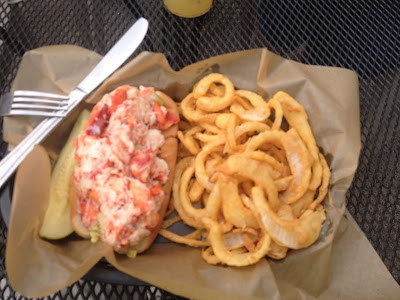Essex Street greets the visitor as soon upon exiting the NPS Visitors Center. Lined with shops and restaurants, this street introduces the humor and history of this fishing settlement.
Complete with souvenir shops,
And a statue of Elizabeth Montgomery!
Salem was established in 1626 by a group of settlers let by Roger Conant, who left a settlement that had been established on Cape Cod by England's Dorchester Company. The goal was to find more fertile, sheltered land than the stormy, rocky struggle they had endured on Cape Cod. Farming and fishing quickly thrived, and in 1629 the town was renamed Salem for the Hebrew word for peace: Shalom. This idyllic life continued until 1692, when fear, disillusionment, and stresses of 17th-century life combined with a strong belief in the Devil and rivalry between families to produce an environment perfect for outrageous and horrible accusations.
In January of 1692, the daughter of Reverend Samuel Parris became ill. William Griggs, the village doctor, was called to provide a diagnosis. His opinion? Bewitchment. This put in motion the forces that would ultimately result in the hanging deaths of nineteen men and women. In addition, one man was crushed to death, several others died in prison, and the lives of many were changed forever.
The Witch House is the only structure remaining in Salem with direct ties to the Salem Witch Trials of 1692. This was the family home of Judge Jonathan Corwin, who was assigned to make preliminary determinations regarding witchcraft and was later appointed to the Court of Oyer and Terminer, which made the final judgements. This court allowed Spectral Evidence, a nebulous idea that actions seen in visions could be an indication of witchcraft, but Judge Corwin's viewpoint on that has never been clearly documented.
The Salem Witch Trials Memorial pays tribute to the twenty citizens who lost their lives to mass hysteral. Each bench is inscribed with the name of an accused, and the date of their death.
Bridgett Bishop was the first to be tried.
She was tried in June by the Court of Oyer (to hear) and Terminer (to decide) and hanged days later. She was followed by 19 others before the court was disbanded by Governor William Phipps in October of that year.
After the horrendous trials, a number of years were required for the village of Salem to recover, but recover it did. In the late 18th century, sailing ships brought goods from around the world to this bustling seaport. The recreation of the "Fame", behind Donna, is documented to be accurate in every detail. So is my lovely Wife!
Capt. Richard Derby built the Derby Dock that the Fame is tied to in about 1770. During the Revolutionary War, Privateers sailed from Derby Dock to prey on English shipping.After the war Derby's ships sailed to the Far East, bringing back unimaginable riches in goods, spices and silk. It soon became apparent that the government would get involved, and soon all the goods became subject to weighing, documenting, and…..taxing…..at the Customs House, located at the head of the dock.
To the right of Custom House is the home of Benjamin Hawkes and William B. Parker. Shortly after their purchase of the home in 1801, Mr. Parker separated and removed his half of the at-that-time 5000 square foot house, leaving his parter with renovation project of his own! Just visible to the right of the Hawkes House is the Derby House.
Wealthy merchant Richard Derby built the house as a wedding present for his second son, Elias Haskett, who made enough money privateering during the Revolutionary War to move his family to a larger home on Exxex Street. Eventually the home became a tenement for immigrant workers who came to Salem to work in the manufacturing industry in the late 19th and early 20th centuries.
Nathaniel Hawthorns House of Seven Gables overlooks the bay. Although never directly linked to the Salem Witch Trials, it will be forever immortalized by native son Nathaniel Hawthorn.
So by now it was deep into rush hour traffic, so dinner called to us, but only as a way of killing some time…..
We had tasted a bowl of soup at the New England Soup Factory for lunch (clam chowder and Lobster Newburg), but that was wearing a bit thin, so we stopped at the Lobster Shanty for dinner. Their claims to fame include: Warm Beer, Lousy Food, Surly Waitresses, Rude Bartenders, Cranky Cooks, Rowdy Regulars and Nervous Lobsters. None of which turned out to be true!
A serving of Mac and Cheese with Lobster and a salad,
And a Lobster Roll served traditional style (cold), completed our meal. Delicious!
See what I mean?
Our wonderful GPS took us on the shortest route home, but certainly not the earliest to navigate. Our route this morning took us on I 95 and I 93 to Salem, but on the way home, we ventured into downtown Boston via the Big Dig tunnel.
We only saw one section where the roof appears to be collapsing!
The travel time this morning was about 45 minutes. This afternoon: an hour and 45 minutes. Savings in miles? About 3. Ya gotta love technology!















No comments:
Post a Comment